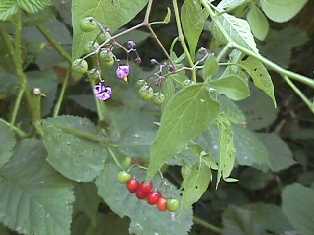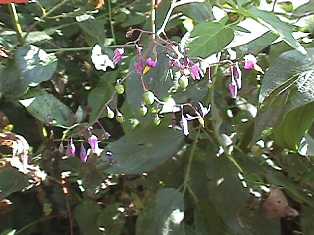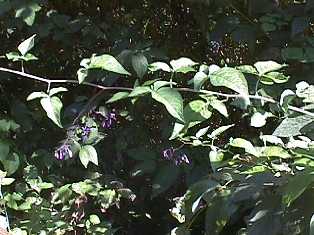


General Species Discription
- Solanum dulcamara is a vine-like perennial plant often found wineding its way up the trunks and branches of wetland bushes and shrubs. it is typically found growing in tangled thickets. Its distinct, small, purple flowers occur in groups of 5 to 25 and arise opposite between the leaves in compound branched inflorescenes.
Leaves
- The leaves of the plant are dark green, spade shaped with smooth margins and prominiant basal lobes and short petioles.
Inflorescence/Flowers
- The flower is fused into a tube shape with petals that curve backwards, with a large yellow steman in the center. Blooms are seen on the plant in June and July.
Fruits
- The ripe berries are bright red and the unripe green berries are often seen interspersed amongst the flowers.
Habitat
- Solanum dulcamara is found in moist thickets, clearings, open woods, waterways, lake shores, ditches, and along fences, mostly in disturbed sites.
Range
- Eurasian species widely introduced across North America, and occurs in all countries in our area.
Similar Species
- Solanum dulcamaras bright purple flowers, red berries, and distinctive leaf shape distinguish it from other vine-like plants found in the Pacific Northwest.
Ecological Value
- The berries of Solanum dulcamara are eaten by birds.
Human Value
- Although the leaves and berries of the plant are reportedly poisonous to humans; the plant if used in the correct applications and dosages by an experienced herbal practitioners can be used for the treatment of gout, skin disorders, rheumatism, bronchitis, and whooping cough. Scientific study has also found it to have anticancer qualities.
References
- 1) Cooke, S.S.,ed. 1997.A Field Guide to the Common Wetland Plants of Western Washington and Northwest Oregon.
Seattle Audubon Society and Washington Native Plant Society. Seattle Audubon Society, Seattle WA,pp190.
2) Hitchcock and Cronquist.1973 Flora of the Pacific Northwest University of Washington Press pp412
3) Tilford G.T. 1997. Edible and Medicinal Plants of the West Mantec Production Company Hong Kong pp186
This page was created by: Susan Muller, August 2000
Return to Northwest Oregon Wetland Plants Project